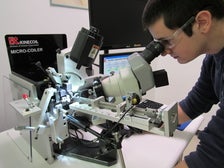Businesses Prep For Impact Of Lower Carbon Cap
The carbon cap shared by nine states, including Massachusetts, will be about 74 million tons lower next year and closer to the states' actual total carbon dioxide output under a new Regional Greenhouse Gas Initiative plan.
"We pushed forcefully and aggressively for this outcome," said Department of Environmental Protection Commissioner Kenneth Kimmel on Thursday. RGGI includes all of New England as well as New York and Maryland, after New Jersey dropped out.
The lowering – which would be ratified by regulation in Massachusetts and legislation elsewhere – would mean higher electricity costs for ratepayers, Bob Rio, executive vice president of the Associated Industries of Massachusetts, told the News Service.
"We are emitting less C02, so what does the region do? They lower the cap to where we are. The only thing that does is raise the prices," Rio said.
There is plenty of headroom under the current cap, of 165 million tons of output over the entire region, Kimmel said, though he said the regional cap and trade system has influenced some of the states' 28 power companies to reduce their emissions. And he said Massachusetts has used the proceeds from carbon allowances to invest in energy efficiency programs.
"The purpose of the program was to put a price on carbon, it was to encourage moving towards a clean energy economy, and it was certainly intended as well to serve as a national model," Kimmel said. He said, "There's no question that it's been very successful, but one thing it hasn't done as effectively as it could is actually reduce emissions in a direct way."
The iron might be hot to enact a cap and trade system on the federal level, state officials said, saying they hoped the regional system would serve as a model.
"Certainly coming off of Sandy and the other natural, weather events that have been historic in nature, and on the eve of getting ready for a big snow storm here tomorrow – so everyone be safe – I think it gives us a chance, not just regionally, but nationally to start to change the discussion points, and I think this announcement here today and the action by the RGGI states could not come at a better time," said Rick Sullivan, the state's Secretary of Energy and Environmental Affairs.
Kimmel said that the new cap, which will be reduced 2.5 percent every year through 2020, would be closer to the actual total carbon output. The cap was closer to the actual output when it was instituted in 2005, but since then carbon dioxide emissions have fallen, "most of all" as a result of the declining cost of natural gas. Though there are environmental concerns about how it is extracted from the earth, natural gas is seen as a "cleaner" fuel than coal.
Rio said that because nearly all of the coal plants in Massachusetts have been phased out by now, there is little headway that can be made in energy efficiency, so the lower cap will drive prices up as plants are forced to buy allowances.
"Currently they're paying about $35 million per year. That's in Massachusetts," said Rio, who said he speaks for the ratepayers who are members of AIM. "I've heard it might double, so now you're talking $70 million."
The actual output is now 91 million tons per year, well below the cap, decreasing demand and putting allowance prices at $1.93 per ton, which is only about 20 percent of the $10-per-ton rate in California, according to Kimmel. Proceeds from the sale of allowances go to energy efficiency programs, which Rio said he supports.
The impact would be a "modest" average of 39 cents per month on a $72 bill for homeowners, Kimmel said.
The program works by requiring power plants that exceed their pro-rated share of the cap to purchase "allowances" for every extra ton of carbon. Plants that are more efficient are able to bank extra allowances.
The proposed changes would set the cap at 91 million to "lock in the dramatic decrease in emissions that we've already seen" and would phase out the number of banked allowances in the system, while adding a cost-containment reserve that would allow RGGI to add allowances into the system to avoid "large price hikes," Kimmel said.
"We haven't got an avalanche of negative comments on this," Kimmel said. He said, "Some of the more efficient power plant producers will probably ultimately benefit from this. Some of the less efficient and dirtier ones won't."
The changes set Massachusetts on track to have cut in half the 2005 rate of power plant carbon emissions by 2020, Kimmel said.
Rio doubted the change would have that same impact.
"We're already at the lowest amount of carbon that you could put up," Rio said. "Now that we're using the cleaner fuels, there's really no place to go."
Others saw room for improvement.
U.S. Rep. Edward Markey, who is running for the U.S. Senate and has been a long-time supporter and sponsor of climate change legislation in Congress, cheered the new, lower emissions cap on Thursday and called the RGGI program a job creator.
"Massachusetts and other Northeast states are proving that smart climate policies save consumers money and create jobs. Climate change is real and so are the economic benefits of addressing it. By continuing to aggressively cut pollution, Massachusetts and New England will show the rest of America the benefits of the clean energy revolution," Markey, the ranking Democrat on the Natural Resources Committee, said in a statement.
Read more












0 Comments